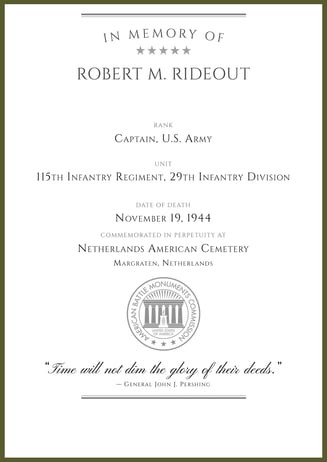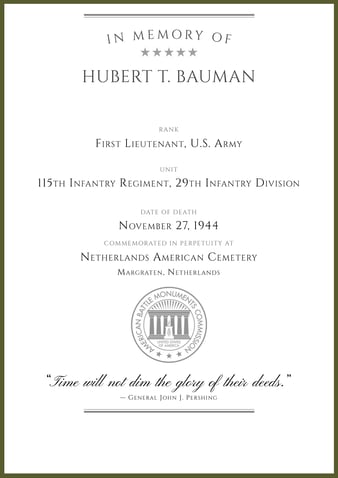In the northwest of Brest, precisely at the South of the cities of Guilers and Bohars, was a group of strongpoints. Built in the villages of Kerognan, Loguillo and Le Moulin du Beuzit, they formed a triangular line of defense.
Thanks to this line of defense, the Germans were able to defend the potential attacks coming from the North, West and East. Kerognan was not a Fort as such but rather an elaborate and strongly defended site with a battery of 105mm Anti-Tank guns.
The mission to take out the guns of Kerognan was assigned to Companies “E” and “G” of the 115th Infantry Regiment, 29th Infantry Division.
The attack on Kerognan strongpoint was the beginning of the Brest campaign for the 2nd Battalion of the 115th Infantry Regiment

“G” Company, 115th Infantry Regiment
On the night of the 7th of September 1944, Sergeant Theodore Finder was ordered by Lieutenant Robert M. Rideout to send four of his men to the hamlet Le Moulin du Beuzit and occupy it.
When the men arrived, two Germans from a machine gun squad were controlling the place. Sergeant Finder and his men took down the machine gun nest without difficulty. In the meantime, one other platoon was sent to the hamlet in support.
Then orders were received to send another platoon at the West of Beuzid. Lieutenant Caldwell took the 1st Platoon and linked with the 8th Infantry Division. Other orders were received to bring another platoon and send one in reserve but it was impossible. The guns of Kerognan strongpoint were firing on them.
On the 8th of September 1944, Lieutenant Caldwell with the 1st Platoon were pinned down by well hidden snipers fire, it will take two hours for the men to locate the source of it.
The men machine gunned the area all around them. It seemed that the fire was coming from the top of the trees! The Germans had built wooden platforms which allowed them to have a full view of the platoon.
Private Arthur Weiland climbed the tree to see if the Germans were dead. The other Germans that the platoon met withdrew a 1000 yards.
The men lost contact with the rest of the Company and without knowing, moved right on to the platoon objective.
“We were far out in front, we saw no enemy, we kept going. We could hear the company moving, we could judge that by the fire…..Then the 13th Infantry Regiment fired on us. We hit the ground “ said Corporal Robert Thorburn.
Thanks to the fire from the 13th Infantry Regiment of the 8th Infantry Division, the men of the 1st Platoon were exactly on their objective. They stayed on their objective until the 2nd Platoon and “E” Company came up abreast.
Sergeant F. Warden leading a mortar squad was positioned in the rear to support the 2nd and the 3rd Platoons. As the fire from the snipers was so intense, he decided to fire on the German riflemen to help the 3rd Platoon instead of covering the 2nd Platoon’s advance.
Initially, the artillery barrage was scheduled at 10:10 hours. The men of the 2nd Platoon waited an extra ten minutes, the artillery which should have fired on the Germans still didn’t come!
Lieutenant John K. Moore therefore decided that they had waited too long and told his men to attack. The 3rd squadron which had the mission to keep contact with “E” Company was split up with the rest of the platoon due to the nature of the soil.
The 1st, 2nd and 3rd squadrons went through the hedgerow atop of the hill and moved down the slope firing as they went. The three squadrons were supported by the tanks which sprayed all the areas around them, in 7 minutes the men were in the outworks.
Sergeant Dudley Floyd testimonial : "We moved out in a skirmish line with scouts leading and we ran most of the way. When we got up to the fort, the Sergeant told us to build up along the hedgerow. As we did, we saw the Jerrys pulling out along a sunken trail leading from the rear of the fort. We tried to put fire on them but we were winded badly. Then we saw a Jerry come back and try to set up a machine gun along the second trail. We all let him have it. A German medic came along and picked up the machine gun, after pulling in the man’s body. We let him get away with it. So far as I could see, only two men, they were from 2nd squad, tried to pull away during the charge, and they joined us at the hedgerow ".
Some of the men of the 3rd squadron were blocked by the German barbed wires and bunched. Lieutenant John K. Moore who was leading the charge ordered them to get down but one German raised his head out of an emplacement which was directly in front of them and started to fire on them with his machine gun.
Thankfully, Private Tony F. De Francisco shot him with his M1 Garand rifle and killed him. The other German soldiers threw grenades on the 3rd Squadron but the men counterattacked.
During the counterattack, Staff Sergeant Gale O. Carroll fired around fifty shells of mortars on another machine gun nest but the Germans were determined to hold their position.
A tank ran toward it from the hedgerows and machine gunned down the nest. One German came out of the nest, jumped on a bike and rode away across the battlefield. The others tried to do the same but died, run down by the tank.
Men of the 2nd Platoon were now 40 yards of the main enemy position, the ground was full of craters and debris, the men crawled toward the guns.
On the right flank the other half of the 3rd squadron was under heavy enemy fire, they fought for about five hours, throwing all their grenades.
The Germans succeeded in escaping via the sunken road.
The situation on the left flank was not good either! The men were looking for cover, the disorganization begun. To motivate the men, one officer had to take an enormous risk to expose himself but the men refused to move further.
The only solution left for the men were the tanks, but as the ground was jammed with craters and debris, one platoon of Engineers was sent to clean it out, to try to create a path for the tanks.
After three hours of works under heavy enemy fire, the Engineers succeeded in clearing a path through the craters and barbed wires. One tank destroyed one machine gun nest on the left flank then moved on the right flank.
In the woods of Kerognan a tank was hit by a German rocket, the crew had to evacuate it. While the crew jumped off, the Germans fired on them.
Sergeant Guy Hazlitt who was not far away from the tank said to Private Morris L. Low: “Come on let’s go. Those guys are going to die if we don’t.”
Note: The witnesses unanimously said these men deserved decoration for gallantry and that it should be the Silver Star!
Lieutenant Rideout will be promoted Captain. He was honored of the Silver Star Medal for his actions on the Kerognan strongpoint and again posthumously in Germany!
“E” Company , 115th Infantry Regiment
On the 7th of September 1944, “E” Company of the 115th Infantry Regiment advanced toward Brest, a patrol composed by seven men commanded by Staff Sergeant Delmer Carson kept well ahead.
Men of the patrol passed to the right of the village of Kerognan and reached the crossroad which allowed to join the hamlet of Kerguillo at the South and Beuzid at the East.
There, the patrol received some enemy machine gun fire. Staff Sergeant Carson decided to fall back to meet the rest of the company and reported to 2nd Lieutenant Roderick Parsch that machine guns were placed there.
During the night a reconnaissance patrol was sent out under Lieutenant Jackson Wooley command. The men went by the same road as the earlier unit but continued beyond. Some sniper fire was received but no serious contact.
Lieutenant Parsch was ordered to attack the strongpoint at 10:00 hours on September 8th. In front of “E” Company, the hedgerows were cut down and barbed wires indicated that the Germans intended to lay heavy fire in all the area.
The men of “E” Company knew that some Anti-Tank guns were emplaced inside the strongpoint and that the air support of the previous day had presumably destroyed the guns...
Just before the attack at H -15, the artillery fired on the Kerognan strongpoint but the shells were fired too far and landed at the rear.
At 10:00 hours, men of “E” Company jumped through the hedgerows and moved into the fields. Each field had a predefined number of men positioned according to its size. The plan of attack was:
- 1st Platoon on the right with a strength of twenty one men;
- 3rd Platoon with eighteen men on the left;
- 2nd Platoon in support with thirty one men.
As the men jumped the hedgerows from the road to the first field, the Germans started to fire on them with their machine guns but no casualties were encountered due to the good covering fire provided by the machine guns, mortars, tanks and artillery fire.
The men continued to advance until they reached a sunken road which was nine feet deep below the surface of the field! A considerable slowing down was caused, fortunately no fire was received because the German soldiers hadn't taken any positions there.
The first platoon advanced on the right of the sunken road, and two fields beyond. From this moment on, machine gun and sniper fire were encountered, the firing was so intense and the men too close to the German positions (Hand grenades were thrown at the Americans) that the platoon was pinned down.
The squad which was on the right was completely exposed, the men had to withdraw and Lieutenant Hubert T. Bauman, Staff Sergeant Burton E. Burfeind and Private Stephen Schott had to cover it.
Staff Sergeant E. Burfeind received a shot through his stomach and died doing his duty. The squad on the left engaged the Germans in a hand grenade fight and succeeded to drove them back. The third squad was a little in the rear to give fire support.
The third platoon was on the left of the first platoon and advanced two fields before being pinned down.
Sergeant Melvin E. Pohl was the first man to reach the second field, he yelled to his platoon and to the 1st Platoon: “Watch for the second sunken trail ahead”. Sergeant Pohl exposed himself accidentally and the Germans shot him, but God was with him, he was not wounded!
The other squad was pinned down, a machine gun raked the area killing the Platoon Sergeant Nicholas Addomia and wounding Sergeant Clinton H. Rock.
Sergeant Carlton Felty took on command of the third squad though the advance would soon continue because he saw the platoon reserve move up. The rocket team followed the order of Sergeant Felty to move but to his left the assistant Private Walter Thull was killed by machine gun fire. He was trying to fire with his rifle but it jammed. Private Gerald Kramer the gunner, played dead for many hours because he was almost in the enemy position.
Finally the mortars started to fire on the Germans to prevent them from organizing a counterattack.
All the men of the third platoon were pinned down, only the first and second squads of the first platoon were able to move and to fire on the Germans.
Those squads joined the second platoon and moved forward three hedgerows.
At 14:00 hours the second platoon joined “G” Company to establish a base of fire while the assault was made into the strongpoint.
To communicate between them the both companies used radio, they were able to know precisely what was the situation at any time.
At last, around 18:00 hours the Germans withdrew to the city of Brest. After 8 hours of continuous and tough fights, the Kerognan strong point fell.
---
 .
. 
Captain Robert M. Rideout died on November 19th, 1944. He is buried at the Netherlands American Cemetery Plot G ; Row 13 ; Grave 13


Lieutenant Hubert T. Bauman paid the ultimate sacrifice on November 27th, 1944. He is buried at the Netherlands American Cemetery Plot C ; Row 6 ; Grave 24
Silver Star Citation Lieutenant Bauman
On November 27th, 1944 during the attack on the strongly-held town of Kirchberg, Germany, Company E sustained heavy casualties including all officers with the exception of First Lieutenant Bauman, company commander ... In desperate need of reinforcements, he was leading a platoon of Company I into position when they were ambushed by a strong enemy force ... In the face of overwhelming odds he elected to fight rather than surrender his command and was killed in an effort to cover the withdrawal of his men ... The courage and leadership displayed by Lieutenant Bauman in this action were of the highest order and reflect great credit upon himself and the military service.
---
Staff Sergeant Burton E. Burfeind was killed in action on September 8th, 1944 aged of 21 years old. He is buried at the Crims Chapel Cemetery, Henderson, Rusk County, Texas.
Resolution H.R. N° 2810
Commending Chuck and Michelle Wright of Frisco for correcting the headstone of deceased World War II veteran Staff Sergeant Burton E. Burfeind.
Chuck and Michelle Wright of Frisco played an essential role in correcting the tombstone of a Texan who lost his life while serving during World War II, and they are truly deserving of special commendation for their successful efforts
U.S. Army Staff Sergeant Burton E. Burfeind was born in Decatur on September 28, 1922, and he served with the 115th Regiment of the 29th Infantry Division; he took part in the D-Day invasion of Normandy on June 6th, and on September 8th, 1944, he was killed in action in Brittany; he was subsequently buried in a cemetery in Rusk County.
Years later, fellow soldier Bill Welch, whose life was saved by Sergeant Burfeind during World War II, discovered that the sergeant’s headstone inscription listed the wrong infantry division!
With the assistance of the Burfeind family, he attempted to have it corrected, but ran into a number of roadblocks. In March 2015, Chuck and Michelle Wright took up the cause and were ultimately able to ensure that the sergeant was properly honored, restoring him to his rightful place in the 29th Infantry Division.
A veteran himself, Chuck Wright was a decorated helicopter pilot in the marine corps, and since leaving the military, he has continued to be a champion for servicemen and women as the host of the program Alliance 4 the Brave on KVCE-AM radio, as a member of the Marine Corps League, and as a leader in the Texas chapter of the Iraq and Afghanistan Veterans of America.
Michelle Wright is active in raising the couple’s two sons, Mason and Travis, and she has served as a Cub Scout leader and engaged in other civic activities. She has also devoted much time to researching the family’s genealogy, tracing it back seven generations to one of Stephen F. Austin’s original 300 settlers.
Thanks to the dedication and hard work of these patriotic Texans, a brave American who gave his life to defend this country has been properly honored for his sacrifice, and Chuck and Michelle Wright may indeed take great pride in this important achievement.
Now, therefore, be it resolved, that the House of Representatives of the 84th Texas Legislature hereby commend Chuck and Michelle Wright for correcting the headstone of U.S. Army Staff Sergeant Burton E. Burfeind and honor them for their selfless service in behalf of Texas veterans.
Be it further resolved, that an official copy of this resolution be prepared for Mr. and Mrs. A Wright as an expression of high regard by the Texas House of Representatives. Turner of Collin
---
Sergeant Melvin E. Pohl died the 11th of September 1976 at the age of 66, he is buried at Woodwan Memorial Park, Joliet Will County, Illinois
---
Sergeant Carlton Felty passed away on August 19th, 1972. He is buried at the West Nottingham Cemetery, Colora, Cecil County, Maryland


Private Walter A. Thull was killed in action on September 8th 1944. He is buried to the Brittany American Cemetery Plot I ; Row 3; Grave 6
Written by Pierre Fallet, WWII Trainee of Normandy American Heroes

















